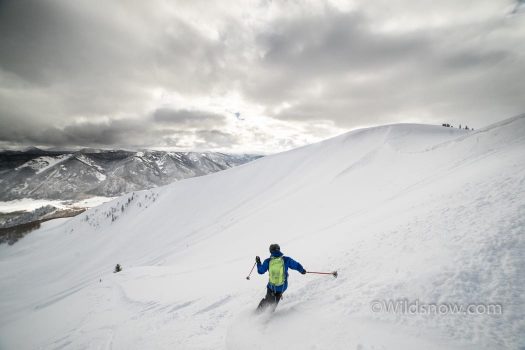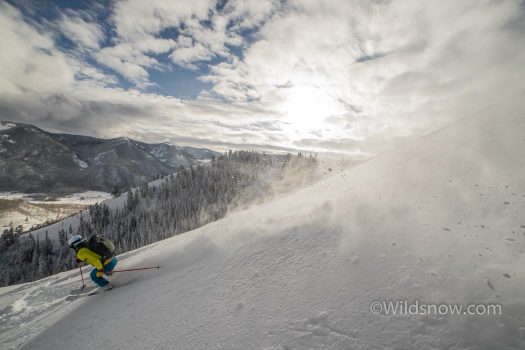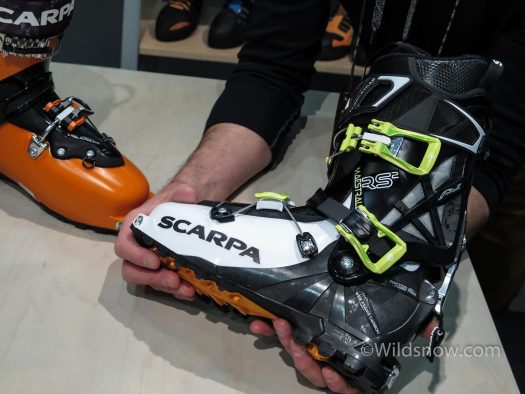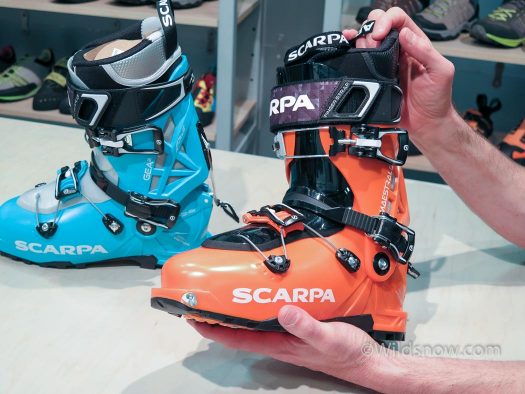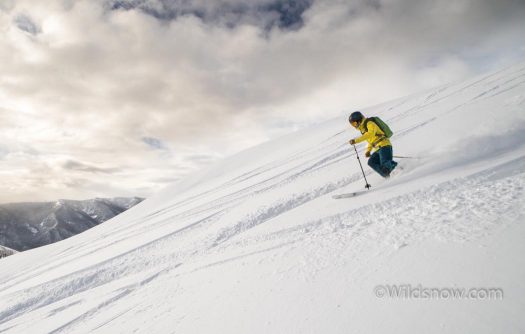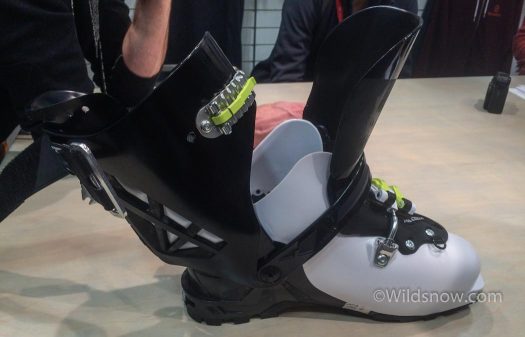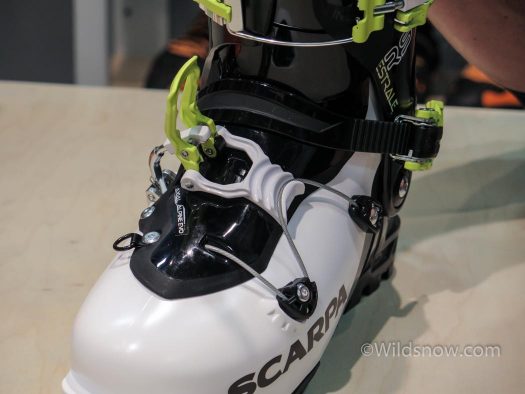G3 and SCARPA invited me to try their new skis and boots during a day of snowcat skiing on natural snow near Park City, Utah. The area has been getting pounded by precip this year — we enjoyed marvelous conditions.
I tested SCARPA Maestrale RS boots and G3 SENDr skis. We used the same kit all day; I thus got a good feel for the skis and boots. That being said, it’s tough to thoroughly evaluate anything in only one day. So we’ll be doing a long term test of both skis and boots throughout this winter. For this post I’ll focus on the new boots from SCARPA. Tomorrow I’ll cover the G3 skis.
SCARPA’s venerable Maestrale boots are well tested here at Wildsnow; I’ve been skiing in them for years. I started using the original orange boot shortly after it was released, and the Maestrale RS has been my go-to all around touring boot for several years. Although the boots are already some of the best out there, there is always room for improvement. I love it when gear companies upgrade good products rather than resting on their laurels, or going back to the drawing board in the name of being “new.”
The redesigned Maestrale boots have several welcome improvements. Upper and lower shells are entirely new; the plastic shaping shaves a bit of weight, and also increases stiffness.
The lean-lock mechanism is changed to be similar to the external type currently used on the SCARPA Alien and F1. This type of lean lock is lighter, and allows less friction in tour mode. It also increases the range of motion from 37 degrees to 60 degrees. (Here at WildSnow we’re not quite sure why so many boot companies have struggled for so long with internal lean lock machinery, it seems prone to failure both from icing as well as manufacturing problems.)
As far as I could tell, the rearward range of motion is now limited by the liner and how much your ankle can flex, rather than the shell (shouldn’t all ski touring boots be that way?). The forward motion feels similar to the old boot. It seems to be just as solid and stiff in ski mode as the old mechanism.
The new external lean lock only has one lock angle of 16° (fine adjustable on the workbench +/- 2°), as opposed to the old, which had two fixed angles of 16° and 20° with no fine adjustment.
The old side-hinge tongue is gone, in favor of a simpler attached version with bolts where the hinges were. The new tongue is also split in the middle, similar to tongues on SCARPA boots such as the Spirit. The warranty department at SCARPA is reportedly overjoyed that they will no longer have to repair tongue hinges. As for us consumers, we liked the ease of entry created by the hinged tongue (when used correctly), but we’ve struggled with broken hinges so we’re fine with this change.
The other major change is that the lowest buckle is eliminated, and the forefoot of the boot is tightened via one buckle connected to an equalized cable system. This is welcome. The front buckle on my old Maestrales didn’t do much except come loose and get caught on stuff.
(A certain skier sometimes known as “His Blogness” is known for removing what he calls the “vestigial buckle” from various 4-buckle boots, and thus receiving disdainful looks from boot designers who’ve spent literally years of their lives figuring out excuses for having 4 buckles. Perhaps those old boot designers retired or something?)
The top buckle is changed slightly, but is effectively the same.
The liner for the boots is redesigned. It is still an Intution thermo-moldable liner (the best, IMHO), but it’s slightly stiffer, with fewer seams in the toe area for increased warmth and comfort.
The RS boots get carbon fiber reinforcements in the lower shell of the boot. The reinforcement made of “Grilamid LFT”, a form of LFT plastic that infuses “long strand” carbon fibers directly into the Grilamid plastic. In an AT boot much of the flex comes from the lower shell flexing, so this increases the stiffness significantly, and reduces weight. RS Maestrale and RS Gea is about 5.5 oz lighter (161 grams) per boot. Way to go SCARPA.
These changes have been implemented in all Maestrale models: Maestale, Maestrale RS, and women’s Gea, Gea RS.
Interestingly, one effect of these redesigns is to make the “normal” Maestrale and RS boot lines much more similar. They are almost identical in weight; only 10 grams difference per boot. They have the same number of buckles, and the same range of motion in tour mode. The only difference is the negligible weight and the flex.
This is good news. Customers can now choose based on downhill performance, much like they do with alpine boots. That’s how it should be! Imagine a world where all AT boots were super-light and toured like tennis shoes, and one could choose solely based on how they felt on the down; wouldn’t that be incredible?
I use a current SCARPA Maestrale for much of my skiing, and used my old boots the day before the test day, so it was fairly easy to compare the two. We spent the day skiing eight good runs. The snow conditions were mostly fast, boot-top powder, but also a bit of wind-board and chundery cat road. We didn’t do any hiking, so I only was able to test the downhill performance of the boot, not the walk mode. Hard work, but someone had to do it.
(FYI: I was skiing on G3’s new SENDr ski, in a 186 length. The SENDr is stiff, and was a good ski to test a stiff boot like the Maestrale RS.)
The first thing I noticed when putting on the boots was the new buckles. The forefoot buckle works really well, and is a big improvement over the old dual buckles.
The forefoot felt nice and snug, and the cable system tightens down evenly, with no pressure points.
The fixed tongue makes the boot slightly harder to get into than the old Maestrales. Increased rear range of motion partially makes up for this; I found it necessary to put the boots in tour mode to put them on. I envision them being somewhat difficult to enter in cold temperatures (those choosing boots for expedition use should note this), although not nearly as bad as an overlap boot. However, I broke several of the old tongue hinges throughout my years of Maestrale use, and the new, simpler attached design is clearly an improvement.
The boots skied well. They felt very similar to my old Maestrale RS boots. The increased stiffness wasn’t immediately apparent, mostly due to the good snow and mellow terrain we were skiing. However, I could feel the stiffness when we skied that chundery snowcat road. Further testing in various conditions, as well as side-by side with the old RS, will be more telling regarding the stiffness. I did release the walk mode a few times — it was fine. The increased range of motion is apparent, especially with the boots unbuckled a bit.
The new boots have improvements in several areas, with no compromises compared to the previous version of the Maestrale series. Well done. We’ll be, of course, evaluating them long term this winter. Here are detailed photos of the boots from the Outdoor Retailer show:
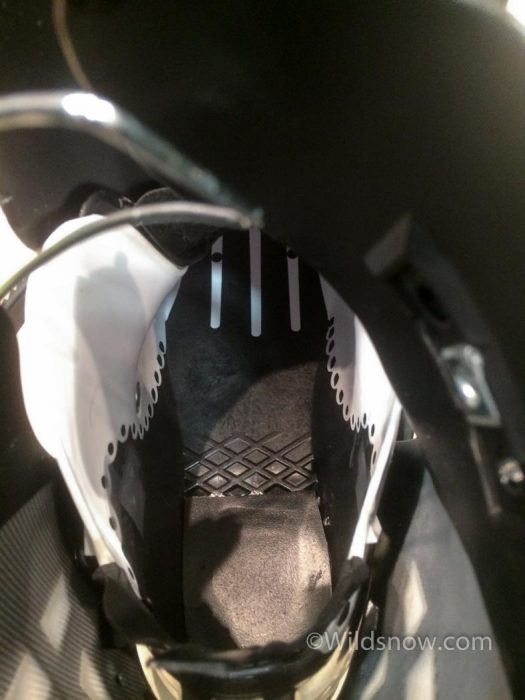
The reinforced LFT plastic (black) extends under the entire length of the boot. This photo is taken looking down at the inside of the boot shell. The toe of the boot is towards the top of the photo.
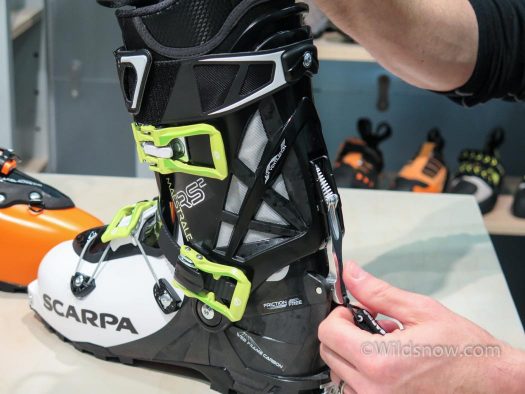
Lean lock mechanism is essentially the same as the one used on the lighter boots in SCARPA’s line. Trickle down bootnomics works.
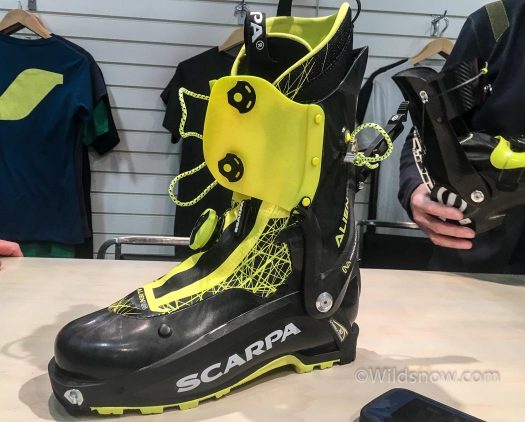
Another new boot from Scarpa for next season: the Alien RS. An updated Alien with LFT reinforced grillamid throughout. I tried them on quickly; more stiff than the current alien, but a bit soft for my taste.
Specs from SCARPA, for further nerding out:
Maestrale:
Size: 24.5 – 32 (half sizes)
Weight: 1400g (one boot, size 27) (old version: 1510g)
Last: 101mm
Flex: 110
Forward lean: 16° +/- 2°
Range of motion: 60°
MSRP: $695
Maestrale RS:
Size: 24.5 – 32 (half sizes)
Weight: 1410g (one boot, size 27) (old version 1571g)
Last: 101mm
Flex: 125
Forward lean: 16° +/- 2°
Range of motion: 60°
MSRP: $795
Gea:
Size: 22.5 – 27 (half sizes)
Weight: 1250g (one boot, size 25)
Last: 101mm
Flex: 110
Forward lean: 14° +/- 2°
Range of motion: 60°
MSRP: $695
Gea RS:
Size: 22.5 – 27 (half sizes)
Weight: 1260g (one boot, size 25)
Last: 101mm
Flex: 125
Forward lean: 16° +/- 2°
Range of motion: 60°
MSRP: $795
Alien RS:
Weight: 850g (one boot, size 27)
Forward lean: 9° and 13°
Range of motion: 60°
MSRP: $870
Available fall 2017.
Louie Dawson earned his Bachelor Degree in Industrial Design from Western Washington University in 2014. When he’s not skiing Mount Baker or somewhere equally as snowy, he’s thinking about new products to make ski mountaineering more fun and safe.

